The first version of the camp called Sunrise sat on the cliff above Stonewall Beach in Chilmark for the better part of a century. It had been a chicken coop back in the 1930s, before Charles and Sophie Langmuir converted it into a fishing shack, which in turn became the family’s vacation retreat. It was a simple and rustic structure with a gabled roof – one bedroom, carpenter-built, and as they described it, “all ocean and sky.” Even as it grew, it didn’t seem to change character. In the 1940s, a garage, a tool shed, and a latrine were added as outbuildings; electricity and running water followed in the ’50s; then the tool shed became a two-person bunkhouse and the main house acquired a screened porch and an outdoor deck in the ’60s. As the decades kept turning, and the family kept multiplying, the garage was transformed into a four-person bunkhouse, the porch into a glassed-in eating room, and the chemical latrine into a respectable bathroom.
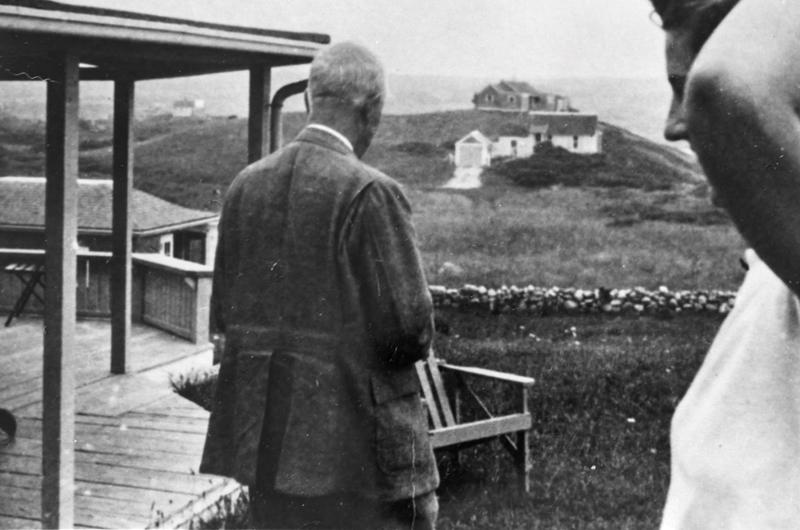
The view to the sea, meanwhile, came ever closer. By the mid-’90s, three generations of the Langmuir family and their friends had spent parts of the summer in the camp, celebrating the beauty of its setting, tinkering with its design, protecting it from the eroding cliffs and advancing waves. The camp had been moved inland three times by then – after the hurricanes of 1938, 1972, and 1991 – and a younger set of Langmuirs were studying the options for its future. Not far from the front deck, they had once again arranged a line of white stones to follow a crack in the land at the edge of the cliff – a quiet sign of impending doom.
Late last fall, before the camp was dismantled and removed from the site, a procession of friends came to say their goodbyes, offering fond memories of weddings and storms and shooting stars as toasts to the place. The camp was empty by then, devoid of the furniture and family effects that describe summer life, but it was still full of its past. Its very structure described its nature – the windows on the sea on three sides, the funky and primitive brick fireplace at center in the living room, the hooks for guns and fishing rods wedded to a wall by a hundred coats of paint, the crescent-shaped dining room with its long scenic window seat. The carpentry, undertaken over the years by family members in collusion with local builders, spoke to its basic style – wide pine planks for the walls and floors, simple shelves for the small kitchen, a trundle bed for the tiny bedroom, and large sliding windows above the window seat. The odd divisions in the roof, the differing wall heights, and a variety of moldings recorded a history of change. Apart from the darkened wood of the gabled ceilings, the whole cozy affair was painted white. An intrinsic sense of color came from the natural world outside.
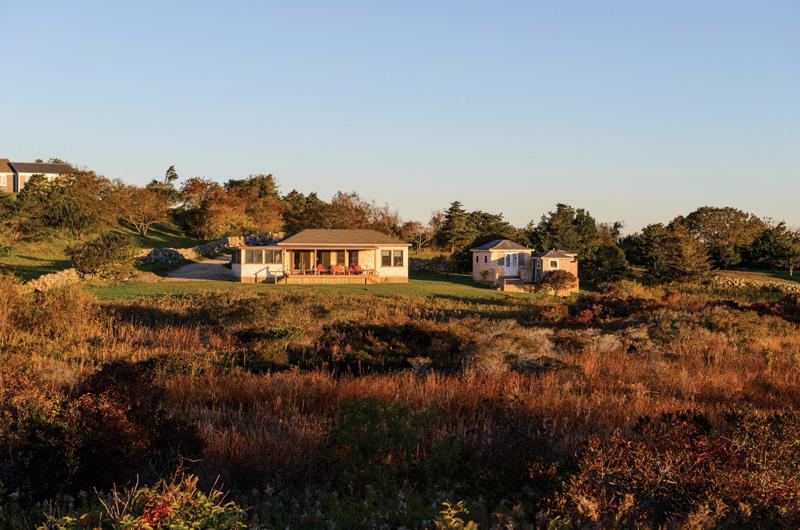
Earlier last year, the Langmuir family had paid its own tribute to Sunrise Camp with the decision to replace the building, too elderly to be moved again, with a virtual replica placed further back on their land. A meandering and ancient stone wall had shown the way to a new site. Given the taste for larger and more luxurious summer homes that is afoot on the Vineyard, it was a quiet but dramatic choice, reached after a decade of family discussion and design. In the end, as the new place reflected, there were few reasons to try to improve upon the simple Island model that had made so many generations very happy. For a while, the two houses sat in friendly coexistence, separated only by a hilly stretch of marshland and grasses – the vintage camp still perched on the precipice, solitary and ephemeral; its successor tucked neatly into a rise some 250 yards back. The first was an intimate, old-fashioned complex of small rooms; the latter, an airy central living space with a cozy bedroom on one side, an eating porch on the other, and a wide front deck facing the sea. Their silhouettes were similar, the square footage and the number of rooms the same. The original camp smelled of must and the sea, the new version of newly minted pine.
There was a time, not too long ago by Vineyard measure, when Chilmark was all saltboxes and camps, many of the latter the hunting and fishing retreats of down-Islanders. Until its removal last winter, the original Langmuir camp was one of the last surviving examples of the small outposts that had once dotted Arcadian stretches of the Island like Lobsterville or Tashmoo, located far from the road, in a surround of fish and game and untamed nature. Until the booming 1980s, when the big changes in land use began to appear, the Vineyard had been slow to enter the twentieth century. As late as the ’50s and ’60s, some Islanders still kept a city and country home, as Julie Flanders of Flanders Real Estate recalls, adding that her own family had a home in Chilmark and a shack in Gay Head, where they spent a carefree month in September. “It was like going back to childhood.”
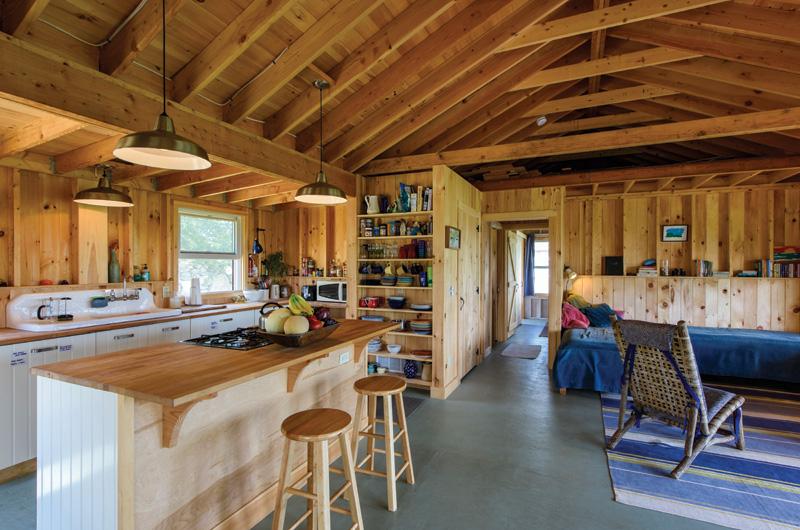
Members of the Langmuir family, now third and fourth generations on the Island, speak in similarly reverential tones about the old Sunrise Camp. “It was a hallowed, even sacred place,” Susan Langmuir, the family spokesperson, says, describing a simplicity and a history that are rooted in a Vineyard of sheep-grazing, remote beach houses, red kitchen pumps, and gas lanterns. The endurance of the camp attests to the workings of their family, beginning with Sophie and Charles, who with the builder Roger Allen created the small compound of buildings, and, sensing the eventuality of severe erosion in its future, obtained the right of way they would need to be able to move back from the encroaching edge. Their children spent their honeymoons on the property in the ’40s, as their grandchildren have since. In the ’70s, ownership passed down to the next generation, who celebrate weddings and family reunions, plan intense workweeks on the property, and in recent years, with two architects and an industrial designer among them, have produced the new camp. As the old house had weathered hurricanes and storms, the family had weathered the house. The roof leaked and the wind blew through gaps in the boards and the sun shined through the wall around the chimney. In the ’90s, when the crest of the cliff was lost to erosion and surfers at Squibnocket began to appear in the kitchen window, it sounded a new alarm.
All of this on-the-scene history of the camp has been recorded in a journal that was originally intended for renters and is now many volumes, rich in anecdotes, vintage photographs, and illustrations by kids and artistic friends. “The house was always a magnet and it has been our glue,” Susan sums up. “In many different ways, it has brought us together. The repeat renters become family too.” Perhaps the most binding effort for the Langmuirs was the decision not to try to move the old camp, but to design a new one to emulate it in style and character, even while incorporating necessary changes. Contemporary building codes, environmental considerations, and new building materials, as well as the long learning experience, all had an impact.
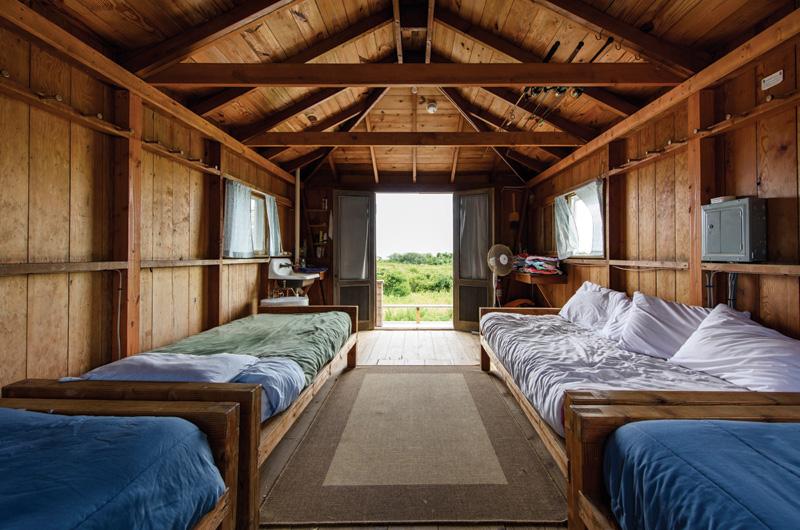
Karl Langmuir, the industrial designer in the family who was the coordinator and project manager, describes the process with quiet pride. “Having never considered the option of building a big house,” he says, “it seems quite wonderful that we have captured some of the virtues of a larger dwelling in our modest 1,000 square feet.” The new camp sits on pilings, which are less disturbing to the land below, where they found (and duly replaced) ancient Native American tools. Neither insulated nor winterized, the structure is tighter now and has double-paned windows and cross ventilation and may prove to be three-seasonal. It also feels bigger, a result of small decisions like the change in the pitch of the roof and the taller door frames that are requisite now, which give the central living room the feeling of a large entertaining space. Nearby, the two bunkhouses and bathroom, relocated from their former site, provide access to private quarters and are linked together by a stretch of new Brazilian teak decking. The ecologically harvested teak was also used for the wide front porch of the camp, which holds a colorful array of Adirondack chairs, made from the kits that were one year’s Christmas presents. In the distance, a few of the chairs have been placed near the edge of the cliff to provide an eye to the old view.
Beneath its new face, Sunrise Camp remains its old self, a simple and dedicated Island summer place. Like its predecessor, it is still a work in progress, which is in its nature, as Karl notes. As of late spring, the construction of bookcases and window seats was not yet complete and small decorating decisions were still under discussion – whether to paint the interior white and where to hang the fishing rods, how to use the wood that was salvaged in the dismantling, and how to display the two mementos that were removed from the old place. One of these treasures is a section of the doorframe on which the children’s advancing heights were recorded. The other is a trompe l’oeil window that had long ago been created by an illustrator friend to replace a rotten section of roof. It pictures a blue sky, streaked with wisps of fair weather clouds, and appears to be gently cracked. These pieces will probably be hung as artwork, but they are also evocative signs of the continuum of the camp.

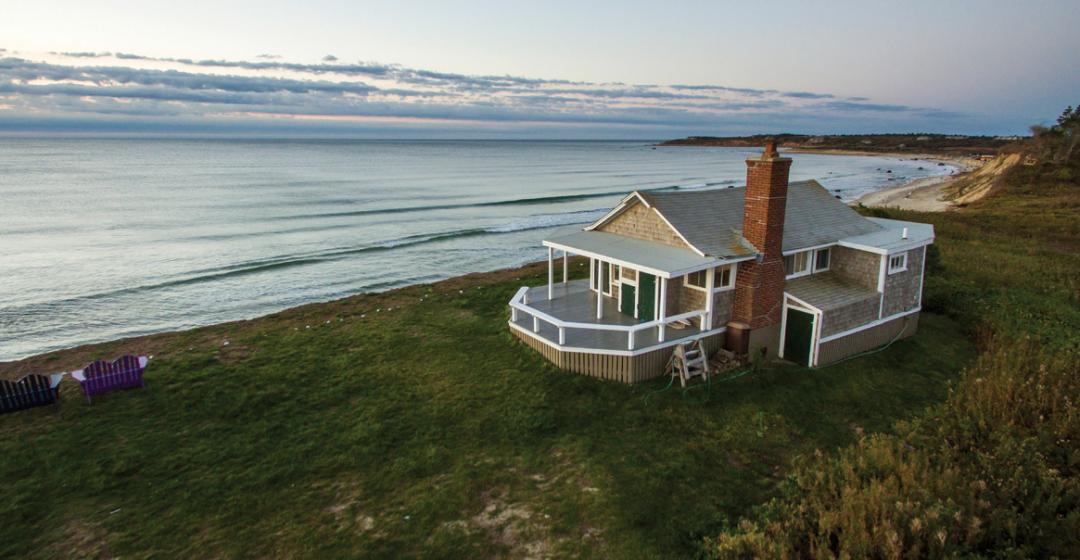


 4 comments
4 comments
Comments (4)